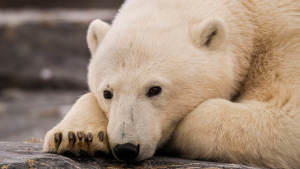
King of the Arctic - the polar bear
The polar bear is perhaps the most well-known symbol of Svalbard and its wilderness, and it is an incredible experience to see one in its natural environment.
At the same time, it is important to understand that these are predators which we are not allowed to disturb, and that visitors should feel lucky if they should see one, rather than disappointed if they do not. The polar bear you don’t see might be relaxing on an iceberg somewhere, enjoying life and eating a seal.
The polar bear is the world’s largest bear, whose native range is largely within the Arctic. The total number of polar bears in the world is estimated to be around 25,000 animals, and of these approximately 3000 are found on Svalbard and the surrounding areas. There are strict protections in place in those countries where polar bears are found, and hunting of polar bears is very controlled and strictly limited. On Svalbard, the bears are completely protected.
Weight, size and age
Fully grown male bears can weigh between 300 - 800 kilograms, and some individuals have reached about a tonne. These male bears can be about 250cm long, when measured from nose to tail, while the female bears are normally only about half the size of the males. They weigh around 150 - 250 kilograms, but can double their weight when they are pregnant. The female bear measures in at about 180 - 200 cm. Like other bears, the polar bear can also stand on two legs, and the longest bears can be nearly 4 metres tall! Polar bears can live to be over 30 years old.
Polar bears have a generous layer of blubber, and the thick fur that covers their bodies has hollow hairs which are both waterproof and insulating. This enables the bears to survive the extreme cold that they face in the Polar region. Their fur looks white, but it is actually colourless. The white colour is actually the result of an optical illusion, caused by the refraction of light.
Polar bear safety
Polar bears do not often attack people, but they are incredibly dangerous. These bears can turn up anywhere in the area, and everyone who leaves the safety of Longyearbyen must carry an appropriate firearm and know how to use it. As a visitor, this means that if you are not on a guided tour, or together with a local person who is carrying this equipment, you should not leave the urban area of Longyearbyen. The best - and safest - way to experience the beautiful Arctic nature, is by going on organised tours with experienced guides.
Tourists and polar bears
As a visitor, your most important duty is to listen to the guide, and follow the advice that they give. A meeting with this kind of predator in its natural environment is an incredible and unique experience, but must be on the polar bear’s terms. Svalbardmiljøloven (Svalbard Environmental Law) states that it is forbidden to seek out polar bears in such a way that the bear is disturbed, or in a way that may cause danger for people or bears. You should therefore be aware that if you see a polar bear during a tour, the group will stay a good distance away and admire the bear through our binoculars, before driving/sailing/walking away from it.
Everyone on Svalbard has a responsibility to respect the Sysselmann’s (Governor) instructions, which may sometimes include restrictions on travel in areas where bears are present. This may mean that we need to change the route on a planned tour. For you as our guest, this means you will have a great story to tell in the lunchroom when you are back at work: "Our tour plans got changed because of polar bears!"
